
Charles Grant Blairfindie Allen was a Canadian science writer and novelist, educated in England. He was a public promoter of evolution in the second half of the nineteenth century.

Nelson Doubleday was a U.S. book publisher and president of Doubleday Company from 1922–1946. His father Frank Nelson Doubleday had founded the business. His son Nelson Doubleday Jr. followed him into it, taking part in expansion and serving as president from 1978–1986.

Neltje Blanchan De Graff Doubleday was a United States scientific historian and nature writer who published several books on wildflowers and birds under the pen name Neltje Blanchan. Her work is known for its synthesis of scientific interest with poetic phrasing.

Euphorbia albomarginata, whitemargin sandmat or rattlesnake weed, is a small low-growing perennial, in the spurge family native to desert, chaparral, and grassland habitats of southwestern North America, from southern and central California to Northern Mexico and Louisiana.
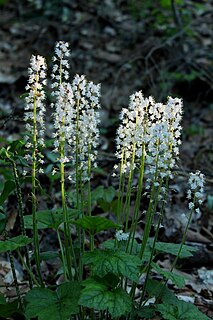
Tiarella cordifolia, the heartleaf foamflower, heartleaved foamflower, Allegheny foamflower, false miterwort, or coolwort, is a species of flowering plant in the saxifrage family, native to North America. It is a herbaceous perennial which is valued in cultivation for its erect stems of foamy cream flowers in summer.
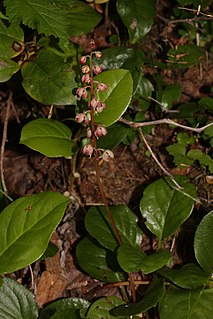
Pyrola asarifolia, commonly known as liverleaf wintergreen, bog wintergreen or pink wintergreen, is a plant species of the genus Pyrola native to western North America. It is found primarily on forest margins at mid latitude in the Pacific Northwest and northern California. It is so named simply because its leaves maintain their green color through winter.

Apocynum androsaemifolium, the fly-trap dogbane or spreading dogbane, is a flowering plant in the Gentianales order. It is common in North America.

Houstonia caerulea, commonly known as azure bluet, Quaker ladies, or bluets, is a perennial species in the family Rubiaceae. It is native to eastern Canada and the eastern United States. It is found in a variety of habitats such as cliffs, alpine zones, forests, meadows and shores of rivers or lakes.
Wild Flowers Worth Knowing is a book published in 1917 as a result of an adaptation by Asa Don Dickinson of Neltje Blanchan's earlier work Nature's Garden (1900).

Nature's Garden: An Aid to Knowledge of our Wild Flowers and their Insect Visitors (1900), republished as Wild Flowers: An Aid to Knowledge of our Wild Flowers and their Insect Visitors (1901), is a book written by nature writer Neltje Blanchan and published by Doubleday, Page & Company. In order to aid the amateur botanist, it used color to classify flowers, noting that this made it easier for novices to identify specimens, and that insects also used color to identify plants. The book also explored the relationship between flowers and the insects that feed on their nectar, using rather anthropomorphic language, and discussed scientific questions of the time, such as Sprengel's theory that orchids produce no nectar. Her description of the flowers also referred to relevant poetry and folklore. Unlike her book Bird Neighbors, the photographs were taken directly from nature.
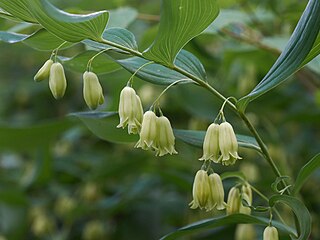
Polygonatum biflorum is an herbaceous flowering plant native to eastern and central North America. The plant is said to possess scars on the rhizome that resemble the ancient Hebrew seal of King Solomon. It is often confused with Solomon's plume, which has upright flowers.
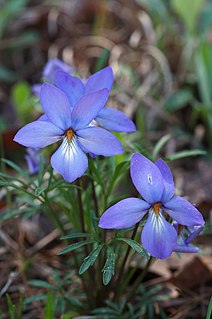
Viola pedata, the birdsfoot violet, bird's-foot violet, or mountain pansy, is a violet native to sandy areas in central and eastern North America.

Veronicastrum virginicum, or Culver's root, is a species of flowering plant in the plantain family, native to the eastern United States and south-eastern Canada. Growing to 200 cm (79 in) tall by 45 cm (18 in) broad, it is an erect herbaceous perennial with slender racemes of white or occasionally pink or purple flowers in summer.

Lilium superbum is a species of true lily native to the eastern and central regions of North America. Common names include Turk's cap lily, turban lily, swamp lily, lily royal, or American tiger lily. The native range of the species extends from southern New Hampshire, Massachusetts, and New York, west to Illinois, Missouri, and Arkansas, and south to Georgia, Alabama, Mississippi, and Florida.
Neltje Doubleday may refer to:
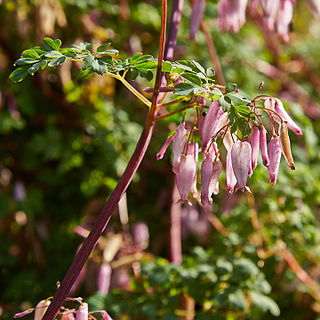
Adlumia fungosa is a species in the Papaveraceae that is commonly known as the Allegheny vine, climbing fumitory, or mountain fringe. It is a herbaceous, creeping, flowering plant and is closely related to the Fumitory genus, Fumaria.
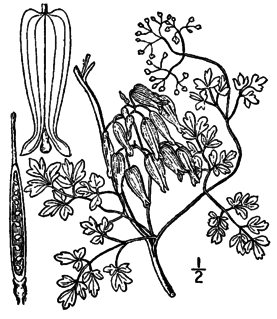
Adlumia is a genus of two species in the family Papaveraceae. The genus name derives from John Adlum (1759–1836), a surveyor, associate judge, plantsman and agriculturist who ran an 80 ha experimental farm in Georgetown, Washington, D.C. The genus was first described and published in Syst. Nat. Vol.2 on page 111 in 1821.
Neltje, also known as Neltje Doubleday Kings, was an American artist, businesswoman and philanthropist. In 2005 Neltje received the Wyoming Governor's Art Award for her artwork; she was an abstract painter.
Robert Stell Lemmon, often Robert S. Lemmon in publications, was an American writer and naturalist. He wrote and lectured on domestic dogs, gardening, wildlife, wild flowers and trees. Most of his writing was non-fiction, but in 1923 he also wrote an adventure short-story called The Bamboo Trap, about an American entomologist caught in a cave in the Ecuadorian jungle.















